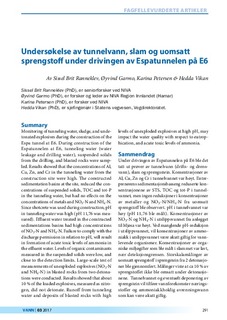| dc.description.abstract | Under drivingen av Espatunnelen på E6 ble det tatt ut prøver av tunnelvann (drifts- og drensvann), slam og sprengsstein. Konsentrasjoner av Al, Cu, Zn og Cr i tunnelvannet var høyt. Entreprenørens sedimentasjonsbasseng reduserte konsentrasjonene av STS, TOC og tot-P i tunnelvannet, men ingen reduksjoner i konsentrasjoner av metaller og NO3-N/NH4-N fra uomsatt sprengstoff ble observert. pH i tunnelvannet var høy (pH 11,76 ble målt). Konsentrasjoner av NO3-N og NH4-N i utslippsvannet fra anlegget til Mjøsa var høyt. Ved manglende pH-reduksjon i utslippsvannet, vil konsentrasjoner av ammoniakk i utslippsvannet være akutt giftig for vannlevende organismer. Konsentrasjoner av organiske miljøgifter som ble målt i slammet var lavt, nær deteksjonsgrensen. Storskalamålinger av uomsatt sprengstoff i sprengstein fra 2 detonasjoner ble gjennomført. Målinger viste at ca 10 % av sprengstoffet ikke ble omsatt under detonasjonene. Tunnelvannet og eventuelt deponering av sprengstein vil tilføre vannforekomster næringsstoffer og ammoniakkholdig avrenningsvann som kan være akutt giftig. --- Monitoring of tunneling water, sludge, and undetonated explosives during the construction of the Espa tunnel at E6. During construction of the Espatunnelen at E6, tunneling water (water leakage and drilling water), suspended solids from the drilling, and blasted rocks were sampled. Results showed that the concentrations of Al, Cu, Zn, and Cr in the tunneling water from the construction site were high. The constructed sedimentation basins at the site, reduced the concentrations of suspended solids, TOC and tot-P in the tunneling water, but had no effects on the concentrations of metals and NO3-N and NH4-N. Since shotcrete was used during construction, pH in tunneling water was high (pH 11,76 was measured). Effluent water treated in the constructed sedimentations basins had high concentrations of NO3-N and NH4-N. Failure to comply with the discharge permission in relation to pH, will result in formation of acute toxic levels of ammonia in the effluent water. Levels of organic contaminants measured in the suspended solids were low, and close to the detection limits. Large-scale test of measurements of unexploded explosives (NO3-N and NH4-N) in blasted rocks from two detonations were conducted. Results showed that about 10 % of the loaded explosives, measured as nitrogen, did not detonate. Runoff from tunneling water and deposits of blasted rocks with high levels of unexploded explosives at high pH, may impact the water quality with respect to eutrophication, and acute toxic levels of ammonia. | nb_NO |
